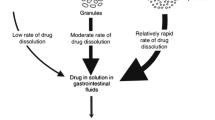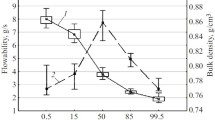Abstract
Purpose. The main objectives of this work are to study the behavior of fluid imbibition into a consolidated matrix through a wet invasive conductivimetric technique, to investigate if the changes in the behavior observed can be related to the drug percolation threshold, and to use this technique for its estimation.
Methods. Matrix tablets were prepared using five sieving fractions of KCl and Eudragit RS-PM. In vitro release assays were carried out on 45 batches. The drug percolation thresholds were estimated following the method of Leuenberger and Bonny, and the results were compared to the obtained employing the conductivimetric technique described in this paper.
Results. The wet conductivimetric technique and the standard method provided similar results for the estimation of the percolation threshold. The presented technique also provides quantitative information about the consolidated matrix.
Conclusions. A new apparatus has been developed for the study of the conductivimetric behavior of matrix tablets during water uptake. This technique provides measurable parameters of fluid penetration and can be used to estimate the drug percolation threshold, providing similar results to the Leuenberger and Bonny method and being clearly faster.
Similar content being viewed by others
references
D. Farin and D. Avnir. Use of fractal geometry to determine effects of surface morphology on drug dissolution. J. Pharm. Sci. 81:54–57 (1992).
G. Valsamia and P. Macheras. Determination of fractal reaction dimension in dissolution studies. Eur. J. Pharm. Sci. 3:163–169 (1995).
T. Li and K. Park. Fractal analysis of pharmaceutical particles by atomic force microscopy. Pharm. Res. 15:1222–1232 (1998).
P. Macheras and P. Agyrakis. Gastrointestinal drug absorption: is it time to consider heterogeneity as well as homogeneity? Pharm. Res. 14:842–847 (1997).
H. Leuenberger, B. D. Rohera, and C. Haas. Percolation theory—a novel approach to solid dosage form design. Int. J. Pharm. 38:109–115 (1987).
H. Leuenberger. The application of percolation theory in powder technology. Adv. Powder Technol. 10:323–352 (1999).
J. D. Bonny and H. Leuenberger. Matrix type controlled release systems: I. Effect of percolation on drug dissolution kinetics. Pharm. Acta Helv. 66:160–164 (1991).
M. J. Férnandez-Hervás, M. T. Vela, M. A. Holgado, J. Cerro, and A. M. Rabasco. Determination of percolation thresholds in matrix type controlled release systems: application of a resistance analysis technique. Int. J. Pharm. 113:39–45 (1995).
J. D. Bonny and H. Leuenberger. Matrix type controlled release systems. II. Percolation effects in non-swellable matrices. Pharm. Acta Helv. 68:25–33 (1993).
S. Budavari. The Merck Index, 11th ed., Merck & Co. Inc., Rahway, 1989, p. 7609.
I. Caraballo, M. Millán, and A. M. Rabasco. Relationship between drug percolation threshold and particle size in matrix tablets. Pharm. Res. 13:387–390 (1996).
M. Millán, I. Caraballo, and A. M. Rabasco. The role of the drug / excipient particle size ratio in the percolation model for tablets. Pharm. Res. 15:216–220 (1998).
D. Stauffer and A. Aharony. Introduction to Percolation Theory, 2nd ed., Burgess Science Press, London, 1991.
Author information
Authors and Affiliations
Corresponding author
Rights and permissions
About this article
Cite this article
Espina-Márquez, Á., Caraballo, I. A New Wet Conductivimetric Method to Estimate the Drug Percolation Threshold. Pharm Res 21, 875–881 (2004). https://doi.org/10.1023/B:PHAM.0000026442.41990.d2
Issue Date:
DOI: https://doi.org/10.1023/B:PHAM.0000026442.41990.d2




